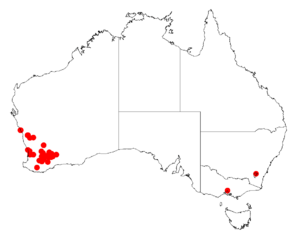Acacia trigonophylla facts for kids
Quick facts for kids Acacia trigonophylla |
|
|---|---|
| Scientific classification | |
| Genus: |
Acacia
|
| Species: |
trigonophylla
|
 |
|
| Occurrence data from AVH | |
Acacia trigonophylla is a type of shrub that belongs to the Acacia plant family. It is naturally found in Western Australia.
What Does Acacia trigonophylla Look Like?
This shrub has many branches and can grow from about 1 to 2.5 meters (3 to 8 feet) tall. Its branches are green and have angles. The leaves, called phyllodes, are like narrow triangles. They are about 1 to 6 centimeters (0.4 to 2.4 inches) long and 1 to 3 millimeters (0.04 to 0.12 inches) wide. This plant blooms with yellow flowers between August and November.
How Was Acacia trigonophylla Named?
The plant was first officially described in 1848 by a botanist named Carl Meissner. He included it in a larger work by Johann Georg Christian Lehmann. For a short time in 2003, another botanist, Leslie Pedley, gave it a different name, Racosperma trigonophyllum. However, by 2006, it was changed back to its original name, Acacia trigonophylla.
The very first sample of this plant used for scientific study was collected by James Drummond in 1844. He found it in an area known as the Swan River Colony. Sometimes, plants with shorter leaves can be mistaken for other Acacia species like Acacia incurva or Acacia daviesioides.
Where Does Acacia trigonophylla Grow?
This plant is found in different areas across Western Australia. You can see it in the Mid West, Wheatbelt, Peel, and Great Southern regions. It grows as far north as Three Springs. To the south, it reaches Mount Barker, and to the east, it can be found near Lake Grace.
Acacia trigonophylla likes to grow in swamps, on hillsides, and among granite rocks. It prefers sandy soils that come from granite or lateritic rocks.

